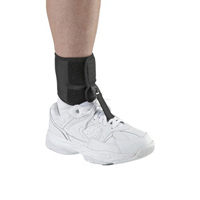Researchers in Australia recently tested the dorsiflexion assist orthosis, better known as the Foot-Up, in a randomized crossover trial. They found that the device helped improve strength and reduce the physiological cost of walking, but that patients still felt as fatigued as they did without the device.

Recently, a team of researchers in Australia put a popular walking aid to the test. The aid, called the dorsiflexion assist orthosis (DAO, brand name Foot-Up, Össur) is made of a flexible material that attaches around the ankle. From the front (anterior) side of the ankle brace, an elastic tether extends toward the top of the shoe, to help keep the toes up while walking. It aids the ankle dorsiflexor muscles, which normally lift the front of the foot, to keep the person walking from tripping over his or her own toes.
.
Stay informed with MS news and information - Sign-up here
For MS patients, caregivers or clinicians, Care to chat about MS? Join Our online COMMUNITY CHAT



